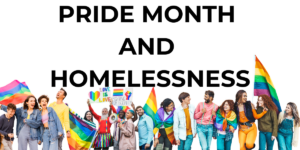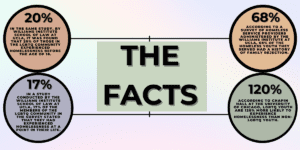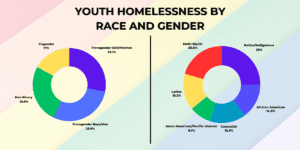
In recent decades, a notable shift has occurred: more and more young individuals are coming out as LGBTQ to their families at increasingly younger ages. While this represents a positive trend toward acceptance and authenticity, it also places these youths in precarious positions. Many face potential rejection by their families while still minors, reliant on their parents for shelter and support. Tragically, when rejected, they often find themselves with nowhere else to go, thrust onto the streets where danger lurks around every corner.
A Disproportionate Crisis
 The statistics paint a stark picture: up to 40% of homeless youth identify as LGBTQ, a staggering figure compared to the general youth population where only 10% identify as LGBTQ. In Washington D.C. alone, this number climbs to 43%. The disparity is largely driven by familial rejection—26% of homeless LGBTQ youth report being forced out of their homes solely because of their sexual orientation or gender identity.
The statistics paint a stark picture: up to 40% of homeless youth identify as LGBTQ, a staggering figure compared to the general youth population where only 10% identify as LGBTQ. In Washington D.C. alone, this number climbs to 43%. The disparity is largely driven by familial rejection—26% of homeless LGBTQ youth report being forced out of their homes solely because of their sexual orientation or gender identity.
A survey conducted by the Williams Institute at UCLA of homeless service providers underscores the severity of the situation:
- 68% of the homeless youth served had a history of family rejection.
- 65% had a history of mental health issues, such as depression or anxiety.
- 54% had experienced family abuse, whether physical, emotional, or sexual.
Vulnerabilities and Risks
Life on the streets is fraught with peril, particularly for LGBTQ youth. Many have suffered abuse at adult shelters, while others avoid these shelters altogether, knowing the risks. The transition from foster care is another significant factor, with studies indicating that 12% to 36% of emancipated foster care youth will experience homelessness at least once after discharge.
Homeless LGBTQ youth are more likely than their heterosexual counterparts to engage in survival sex—the exchange of sexual favors for basic needs like food, clothing, and shelter. A Canadian study found that transgender youth are three times more likely to engage in survival sex than cisgender youth. The National LGBTQ Task Force discovered that the primary reason for this was simply to secure a bed for the night.
Disparities Amongst Different Groups 
The rates of homelessness and housing instability vary significantly across different racial and ethnic groups within the LGBTQ community:
- Native/Indigenous LGBTQ Youth: Nearly half (44%) have experienced homelessness or housing instability, the highest among all groups.
- Multiracial LGBTQ Youth: 36% have faced these challenges.
- Transgender and Nonbinary Youth: Higher rates are reported among transgender girls/women (38%), transgender boys/men (39%), and nonbinary youth (35%) compared to 23% of cisgender LGBQ youth.
- Latinx LGBTQ Youth: 27% have experienced homelessness or housing instability.
- White LGBTQ Youth: 27% report facing these issues.
- Black LGBTQ Youth: 26% have experienced these hardships.
- Asian American/Pacific Islander Youth: 16% report experiencing homelessness or housing instability.
The Human Toll
The human toll of this crisis is profound. LGBTQ homeless youth are at a higher risk for victimization, mental health issues, and unsafe sexual practices. Alarmingly, 58.7% of LGBTQ homeless youth have been sexually victimized, compared to 33.4% of heterosexual homeless youth. They are roughly 7.4 times more likely to experience acts of sexual violence than their heterosexual peers.
The mental health impacts are equally severe. LGBTQ homeless youth attempt suicide at much higher rates (62%) compared to heterosexual homeless youth (29%). These figures highlight the urgent need for targeted support and intervention.
Moving Forward
Addressing this crisis requires a multi-faceted approach. Support systems need to be strengthened to provide safe, affirming spaces for LGBTQ youth. Increased funding for shelters and programs that cater specifically to their needs is essential. Additionally, societal attitudes must continue to shift towards acceptance and understanding to reduce the incidences of family rejection and abuse.
As communities and advocates, it is our responsibility to ensure that no youth, regardless of their sexual orientation or gender identity, is left without a safe place to call home. The plight of homeless LGBTQ youth is a pressing issue that demands our immediate attention and concerted action.
Resources
If you or someone who know is a part of the LGBTQIA+ community and are in crisis, here are some amazing organizations who are here to help;
- S.A.F.E. (Stop Abuse For Everyone) – (512) 267 – SAFE [7233]
- OUT Youth – (512) 419 – 1233 [https://www.outyouth.org/]
- Austin Galano Club – [https://www.austingalano.org/groups/llll/]
- Queertopia – [https://www.queertopiatx.org/]
- Trevor Project – (1 – 866 – 488 – 7386) [https://www.thetrevorproject.org/get-help/]
- LGBT National Youth Hotline ( ages 23 and younger) – (800 – 246 – 7743) [https://lgbthotline.org/]
- True Colors United – (212) – 461 – 4401 [https://truecolorsunited.org/]
- Trans Lifeline – (877) 565 – 8860 [https://translifeline.org/]

SOURCE:
https://www.thetrevorproject.org/research-briefs/homelessness-and-housing-instability-among-lgbtq-youth-feb-2022/

